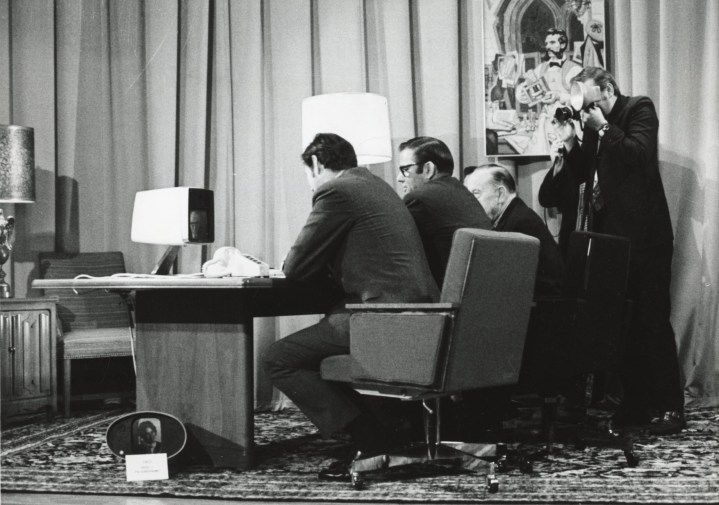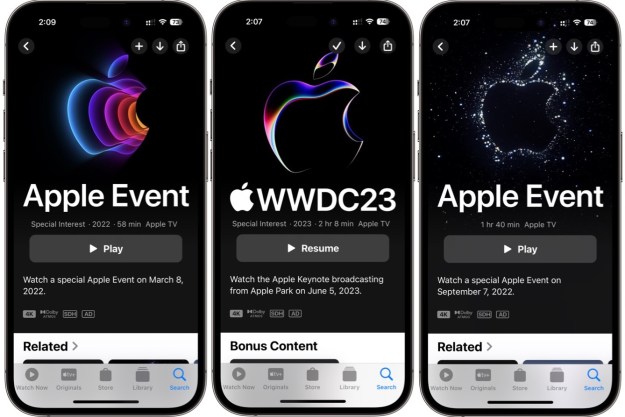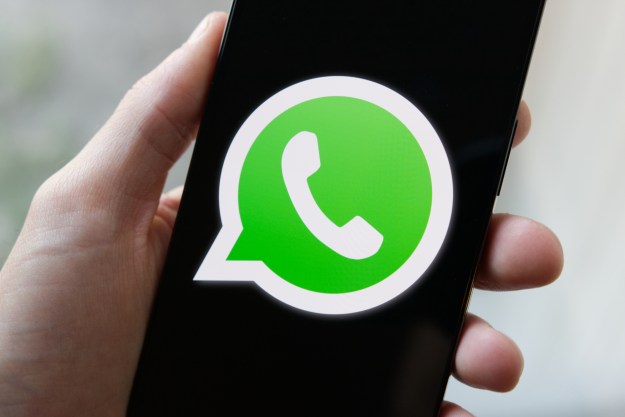
“Here’s looking at you,” said Pittsburgh Mayor Pete Flaherty, staring at the tiny face of John Harper, chairman of Alcoa, on a small, low-resolution, black-and-white display, on the desk in front of him.
The date was June 30, 1970, and the occasion was the first public demonstration of Bell Labs and AT&T’s Picturephone system, held in a chintzy living room set in the Bell Telephone HQ auditorium in Pittsburgh. Long before Zoom, Skype, FaceTime, and Google Hangouts were a daily reality, this highly publicized event was supposed to signal the start of a network of two-way videophones that would stretch across first Pittsburgh, then the United States, and eventually the world. AT&T’s Picturephone was, in essence, a combination telephone and TV set. AT&T, which spent an estimated $500 million on the endeavor, predicted that, by 1975, there would be 50,000 such Picturephones in 25 cities around America. By 1980, they predicted that 1 million units would be sold.
Things didn’t exactly happen like that.
Commercially speaking, the Picturephone was a flop. It was too expensive, costing a monthly fee of almost $1,000 in today’s terms for access to the technology, and an additional charge per minute of use. Customers worried about how they would appear on the screen of the other user; there being no vanity picture-in-picture window for them to see themselves during the call. It was also unwieldy. In order to work, the Picturephone tied up multiple phone lines simultaneously to get sufficient bandwidth to transmit the necessary audio and video analog signals.
By 1972, only a handful of sets had been sold in Pittsburgh. When AT&T switched CEOs the year after that, the writing was on the wall, and the project was brutally canceled.
A machine ahead of its time
Half a century on from AT&T’s original public demonstration of the first commercial Picturephone, it’s safe to say that the idea has been vindicated. Like the Apple Newton or General Magic, two of the most notable Silicon Valley failed attempts to build a mobile device in the 1990s, we now know that AT&T was telling the right story; they were just doing it years before people were listening.
“[The Picturephone] was so far ahead of its time,” Chris Harrison, director of the Future Interfaces Group at Carnegie Mellon University, which holds two of the surviving Picturephones in its university archives, told Digital Trends. “Having opened these machines up to take photos of the interior, it was absolutely jam-packed [with cutting-edge technology for 1970]. The industrial design was just incredible. It was a beautiful machine. It must have been so futuristic at that moment. It looks like something right out of The Jetsons.”
Among Harrison’s favorite details of the AT&T Picturephone is a desktop sharing feature, which allowed users to share their literal desktops (remember that this was a time before graphical user interfaces gave us metaphorical desktops to work on). By flipping a small mirror over the device’s camera, you could show the person on the other end of the two-way conversation an object on your desk. “You could have a piece of paper in the view and write on it, and the other person would see that in real time,” Harrison said. “They really thought about this as a business tool.”

To celebrate today’s 50th anniversary of the original Picturephone demonstration, Michael Morris, chairman of Alcoa’s Board of Directors, spoke today via Zoom call with the current Mayor of Pittsburgh, William Peduto. Before coronavirus struck, Harrison said the plan was to have been for Morris and Peduto to use the original Picturephones, now modified for current videocalling software. However, plans were thrown into disarray by COVID-19, and the reenactment was more symbolic than anything.
A long history of failure before its success
For the longest time, video calling seemed like the ultimate science fiction dream. AT&T’s failure with the Picturephone seemed to simply hammer this point home. Had the concept not seemed so exciting, it doubtless would have died right there in the decade of disco and Watergate.
“The video call was this technology that was always on the cusp of widespread adoption, but never quite gets there,” Andrew Meade McGee, CLIR Postdoctoral Fellow in the History of Science and Computing at Carnegie Mellon University, told Digital Trends. “It was futuristic technology that [always appeared to be] just around the corner.”
The Picturephone was not, in fact, the first time researchers had tried to make video calling a reality. Virtually since the moment that Alexander Graham Bell patented the telephone in 1876, there was exploration into a similar calling system built around images as well as voice. The French science fiction writer Louis Figuier claimed that Bell was working on something called a “telephonoscope” combining real-time sound and image. An 1879 cartoon by George du Maurier, which appeared in the Punch Almanack, jokingly depicted a similar device, supposedly created by the American inventor Thomas Edison. Trading cards produced under the name “In the year 2000,” sold as souvenirs at the 1900 Paris Exposition, imagined “Correspondance Cinema-Phono-Telegraphique.”
The idea, for the same reason that it tantalized engineers, cropped up in works of fiction. An 1889 story by Jules Verne, “In the year 2889,” describes how people of the future communicate via a “telephote.” “The transmission of speech is an old story,” he wrote. “The transmission of images by means of sensitive mirrors connected by wires is a thing but of yesterday.” The first screen appearance of video calling may well be Fritz Lang’s 1927 science fiction masterpiece Metropolis — although it was far from the last time that it was depicted on screen. (Stanley Kubrick’s 1968 2001: A Space Odyssey is a notable example.)
There were various prototypes as well, although they lacked the underlying infrastructure of the 1970 Picturephone call. A Bell Labs prototype was shown off at the 1964 World’s Fair, along with future wonders including IBM’s System/360 series of computer mainframes, handwriting recognition technology, machine translation, and architects’ models of the forthcoming Twin Towers of the World Trade Center. Soon after, Bell Labs created public prototype Picturephone booths in New York, Chicago, and Washington, D.C. These allowed people to make three-minute calls across the U.S. for a whopping $27. For whatever reason, payphones costing the modern equivalent of $223 for 180 seconds of conversation never took off.
Even after the failure of the 1970s Picturephone, AT&T didn’t entirely give up on the idea of a commercial line of video calling devices. In 1992, it tried again with the full color, 10fps Videophone 2500. This time, both video and audio were transmitted along one telephone line, although this compression resulted in poor quality picture and sound. The following year, it slashed $500 off the $1,499 price, and threw in the towel by 1995.
Video calling is everywhere today
Given our current reliance on video calling, this history of failure might seem surprising. As recently as the early 2000s, it still wasn’t clear that video calls would ever become a mainstream proposition. A 2004 paper, published in the journal Technological Forecasting and Social Change, was titled “On the persistence of lackluster demand — the history of the video telephone.” It offered up the videophone as a case study in technology that repeatedly failed to catch on. Some lessons derived by the authors include “not every new technology leads to stunning market success,” “just because the press says it will, does not mean it will” and “technological convergence is not a certainty.”
Today, of course, we know different. Just a couple of years after that paper was published, Skype video calling launched on Windows. Before long, every desktop computer and laptop shipped with a built-in webcam. Then came smartphones and tablets with front-facing cameras, ubiquitous broadband, and the advent of services like FaceTime, Google Hangouts, and Zoom.

While the core dream remains the same as it was in the 1970s (and, for that matter, in the 1870s), the technology has continued to iterate. For example, Apple’s iOS 13 used AR trickery to “correct” the eyeline on FaceTime calls, meaning that users no longer needed to choose between looking at the person (and appearing to be staring off-screen) or at their camera (and appearing to look at the other person, but not actually be looking at them on the screen). Tweaks like this, minor as they might be, help make video calls even more immersive and like you’re having an everyday chat with a live person.
And yet, the irony of ironies, video calling has perhaps become so normalized that we no longer think of it as particularly special.
“We’re in this moment now where the window in which this was a spectacular, futuristic technology quickly compressed into a kind of mundane ubiquity,” McGee said. “Now it’s just another utility. It’s an essential action that is routine, so it’s lost some of that aura of grandeur. But even with that being the case, every so often you’ll get someone on a Zoom call or video chat who makes that joke about ‘this is the future. I’m talking to you in picture, thousands of miles away.’”
The engineers of Bell Labs and AT&T deserve, perhaps, a retrospective pat on the back. And maybe all of us will learn a valuable lesson about writing off today’s flops. You never know what half a century’s progress will bring!
Editors' Recommendations
- I turned my phone into a camera, and I don’t want to go back
- The iPhone 15 Pro has a killer camera feature you’ll never use
- I turned my iPhone into one of 2023’s coolest Android phones
- I found the perfect iPhone 15 accessory, and it’s only $50
- Here’s why your phone got an emergency alert today





